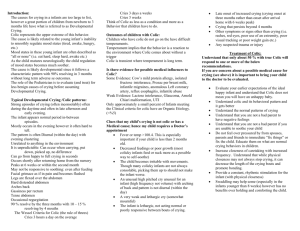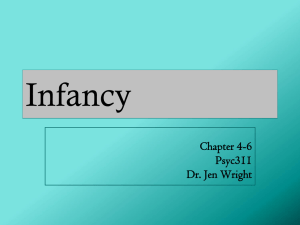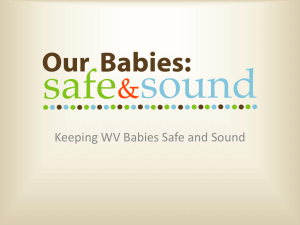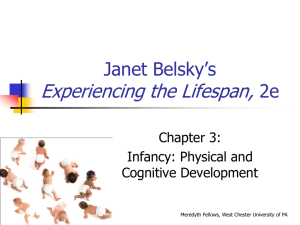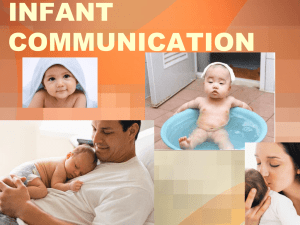Fussy Babies
advertisement
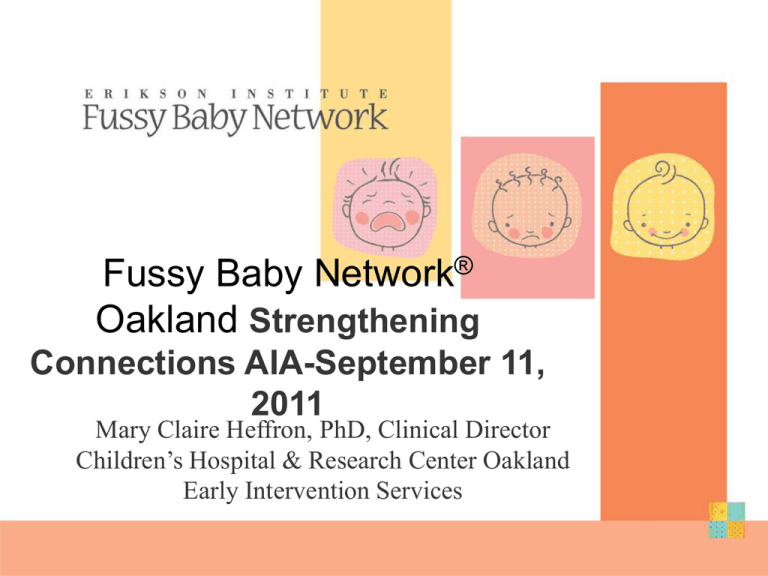
Fussy Baby Network® Oakland Strengthening Connections AIA-September 11, 2011 Mary Claire Heffron, PhD, Clinical Director Children’s Hospital & Research Center Oakland Early Intervention Services Admissions to ER for Infant Crying 3 0 33% had diagnosis of colic/crying 2 5 2 0 15 10 5 1 2 3 4 5 6 7 8 9 10 11 12 13 14 15 16 17 18 19 20 0 Age in Months Gray et al, 2004 Fussy Babies in the ED Who are fussy babies? All Babies Cry Crying as a Regulatory Function • Increases lung capacity at birth • Increases motor activity • Helps regulate temperature • Triggers attachment system/social interaction Lester, 2006 What is it like to hear a baby cry inconsolably? Normal Crying Curve 6 weeks • Peaks at 4-6 weeks • First documented in Brazelton’s practice • Replicated 15 times • Across cultures 12 weeks Barr, Konner, Bakeman, & Adamson, 1991; Brazelton, 1962; St. James-Roberts, Bowyer, Varghese, & Sawdon, 1994 “The Witching Hour” Brazelton, 1962 Large difference between infants Brazelton, 1962 Crying Curve for Premature Babies • Timing of crying peak is same as full-terms – 4-6 weeks corrected age • Quality of crying may be different than full-terms • “He never cried in the nursery” Definitions • Excessive crying: more than average amount of crying • Colic: excessive crying plus sudden onset, more aversive acoustical qualities, physical signs, more inconsolability (Lester et al, 1990) • Persistent crying: crying past “cry curve” months (past 4 months) • FBN Fussy Baby: any baby from birth to one year whose parent feels is difficult for him/her to console, feed, or help sleep Wessel’s Rule of 3s for Colic • Rule of 3s – More than 3 hours/day – More than 3 days/week – More than 3 weeks • No single known cause Wessel, 1954 Colic is Not Linked to: • • • • • Birth order Gender Feeding style SES Colic can occur in healthy babies, in spite of excellent parenting Excessive Crying Plus: • Sudden onset – Unpredictable • Cry quality – Higher pitch, reaches peak quickly – Like a pain cry • Physical signs “Late afternoon fist-shaking rage” – Clenched fists – Grimace/flushing – Gas/distention • Inconsolable Lester, Boukydis, Garcia-Coll, & Hole, 1990 How Long does Colic Last? Begins early: • 100% by 3 weeks End varies: • 50% by 2 months • 80% by 3 months • 90% by 4 months Weissbluth, 1998 Different pathways to excessive crying • Immaturity of GI tract • Cow’s milk/lactose intolerance • Sensory thresholds • Transient regulatory problem • Abnormal sensitivity of CNS • Prenatal influences • Parent/child relationship distress Evaluation and treatment by maternal-infant mental health specialist Maternal psychotherapy Reflux medication Smaller, frequent meals Upright positioning Thickening feeds MaternalInfant Distress Maternal dairy elimination if breastfed. Formula change to soy-based or elemental formula Reflux Regulatory problems, neurological hypersensitivity Immaturity of the digestive system Excessive gas Milk protein allergy Evaluation and treatment by medical professionals Probiotic foods or supplements Targeted antibiotics Excessive Crying in Infancy Underlying medical condition or infection Crying of normal development Bacterial over Growth imbalance Temperament Colic Swaddling, Side positioning, Shushing, Swinging, Sucking Environmental dampening Infant massage / touch Chiropractic manipulation Simethicone (Mylicon) Chamomile Gripe water Dill oil, Fennel oil Dicyclomine (Bentyl) Underlying Medical Reasons – Reflux – Milk Protein Allergy – Serious Infection (rare) Gastroesophageal Reflux & GERD • Spitting up is a normal part of growing up as a baby • Most babies have reflux, with peak symptoms around 4 months of age, and resolution by 12 months. • In about 8% of babies, reflux results in concerning symptoms, and we then assume that the infant suffers from gastroesophageal reflux disease, or GERD. • GERD is defined as chronic symptoms or mucosal damage produced by the abnormal reflux in the esophagus. • If the reflux reaches the throat, it may be called laryngopharyngeal reflux disease. Gastroesophageal Reflux •Lower esophageal sphincter (LES) is a muscle between the esophagus and the stomach •LES matures at 6-7 weeks •While immature, it does not close tightly, so feedings can go in a reverse direction, from stomach to esophagus Mechanisms of Reflux • Maturation, length and angle of LES affect reflux • Breathing (Inspiration and expiration) trigger contraction of different portions of LES • Gastric distension (over feeding) and altered angle of LES (flexed position) can increase reflux When to Suspect GERD in an Excessive Crier • Crying that is worse around feeding • Frequent spitting up that seems uncomfortable • Refusing feeding • Trouble with weight gain • Back arching (right) • Coughing, choking, gagging • Breathing difficulty Regulatory Imbalance • Imbalance between excitatory (arousing) processes and inhibitory (calming) processes • Imbalance impedes infant’s regulation of stable sleeping and waking states and smooth transitions between states. The underlying cause is not known. – Sucrose hypothesis: central self-soothing mechanism is not developed – GO systems (sympathetic nervous system) develops before SLOW systems (parasympathetic) – Transient immaturity or temperament – Prenatally acquired constitutional factors Lester, Boukydis,Garcia-Coll, Hole, & Peucker, 1992; Papoušek & Papoušek, 1984 Infant Sensitivities • Prematurity • Drug exposure • Sensitive sensory system Psychosocial Distress • • • • Perinatal Mood Disorder Birth trauma Limited family resources Parental conflict What Stresses Parents the Most Photo courtesy of Ruth Fremson/The New York Times, 2008 from: http://well.blogs.nytimes.com/2008/09/05/deliverymethod-affects-brain-response-to-babys-cry/#more-511 • Prolonged length of cry bouts • High intensity of cry (high cry to fuss ratio) • Cry not reduced by extra carrying • Resistance to soothing which makes parents feel out of control St. James Roberts, 2007 Crying, Colic, and Parental Perceptions “The actual duration of crying at a given moment seems to be less relevant than the parent’s perception of the crying of their infant in the long term.” Reijneveld et al, 2004, p. 1342 Cultural Context of Crying • How does culture perceive crying? – Positive – Negative • What strategies are used in various cultures? – Distal caregiving – Proximal caregiving How would your grandma calm a fussy baby? Proximal Caregiving • Babies communicate through movement and cries • Mothers sense babies’ arousal through body signals and soothe before crying begins Lester, 2006 Distal Caregiving • Cry now used to call for basic care • Have longer crying bouts • May have earlier consolidation of sleep Why worry about fussy babies? • • • • Risk for child behavior/development problems Risk for parent-child relationship problems Risk for child abuse Risk for family stress and maternal depression Risks to Behavior & Development Severe colic/persistent excessive crying in infancy past 5 months has been linked to the following child outcomes: • • • • • • Motor, language, and cognitive delays Behavioral problems (“temper tantrums”) Negative reactivity (“fussiness”) Sleep disorders Feeding problems Hyperactivity DeGangi et al., 2000; DeSantis et al, 2005; Kries, Kalies, & Papousek, 2006; Papousek & von Hofacker, 1998; Rautava et al., 1995; Savino et al., 1995; Wake et al., 2006; Wolke, Rizzo, & Woods, 2002 Risks to Behavior & Development • Infant cry, sleep, & feeding problems associated with externalizing behavior and ADHD across 22 longitudinal studies, particularly in families with multiple risks • 75% of babies babies seen in Brown University colic clinic demonstrated some degree of atypical sensory processing between 3-8 years of age • Hours of fussing—not crying—were associated with less efficient skills in sensory processing, coping, and externalizing behaviors Desantis, Coster, Bogsby, & Lester, 2005; Hemmi, Wolke, Schneider, 2011 Risk for Child Abuse 2.75 hours Crying Duration Shaking Baby Cases Age in Weeks Barr, Trent, & Cross, 2006 Infant Crying & SBS Lee, Barr, Catherine & Wicks, 2007 Risk for Maternal Depression • “Double Whammy” of Infant Colic and Maternal Depression • 46 % of mothers seen at Brown University Colic Clinic had moderate to high depression Maxted et al., 2005 Maternal Depression In mother In infant • • • • • • • poor eye contact • unpredictable sleeping and/or eating patterns after 4 months • constricted affect • difficult to comfort or soothe • developmental delays frequent crying appetite change sleep problems moderate to high anxiety panic attacks feeling unable to cope, worthless, despair, guilt • sluggishness that interferes with childcare • expression of little positive emotion with infant • fear of harming child or self Clark, 1994; 2003 Parents ask: “Where is the finish line?” “You think it is never going to end…” Negative emotions • • • • • • • Wishing infancy away “ It’s supposed to be bliss… I just want it to be over.” Progression of emotions Overwhelmed Angry Guilty “Do you ever get mad at her? …feel like you’re going to hurt her?” Family Impact • Disrupted lives • Criticism and social isolation • Search for diagnosis • Maternal depression • Parental conflict • Parent-infant relationship distress Long & Johnson, 2001; Maxted et al., 2005; Wake et al., 2006 “No one said it would be this hard..” • Disrupted daily routines -“Just doing the simplest things…it’s just not possible” • Disrupted personal lives -“You read about stress in the marriage. This is the stress in the marriage” • Disrupted social lives -Now that we have a baby, we can’t even leave the house” Criticism and Social Isolation • Family criticism: “If only you would..” • Parental guilt: “I’m not hurting her, I swear…” • Social isolation: “I feel so alone and I can’t take her any where” Categories of Need for Fussy Baby Oakland • • • • • • Emerging developmental differences Medical concerns Emerging parent child relationship concerns Family-Baby Stress Parental mental health concerns High risk family (more than 3 risk factors) Age range of infants 3% 3% 13% 0-3 months 4-6 months 7-9 months 57% 24% 10-12 months Did not report /missing Screening for Depression & Anxiety Use of focused questions: • During the past month, have you often been bothered by feeling down, depressed or hopeless? • During the past month, have you often been bothered by little interest or pleasure in doing things? • On a scale of 1 to 5, how stressed do you feel about your baby’s crying/sleeping/feeding? Worry Scale Parents’ Two Worries: • Is my baby alright? • Am I a good enough parent? T. Berry Brazelton, MD America’s Pediatrician Supportive interventions which embrace a biopsychosocial perspective and which focus on the baby, parents, and parent/baby/family relationships can build competence, decrease stress/risk, and support healthy development Gilkerson, Gray, Mork, 2005; Papousek, 2007; Maldonado, & Garcia, 1996; Keefe, et al., 2006 ; Maxted, et al., 2005 Help From a Dual Perspective 1. Help parents in the now moment with their urgent concern 2. With your eye on their future • Parent’s confidence • Parent’s view of child • Relationship Fussy Baby Network Approach • Engages families around feeding, sleeping, crying and regulatory concerns • Three goals: – Increase parental confidence – Strengthen parent-child relationship – Promote healthy development of parents and infants Photo courtesy of: http://images.sciencedaily.com Maternal Depression PRIME-MD PHQ Responses 40 35 30 20 25 Negatives 20 Positives 15 13 10 16 5 4 0 1 2 Administration Fussy Baby Network Family Feedback Survey 5.00 4.50 4.00 3.50 Scale of 1 to 5 How distressed did you feel about your Fussy Baby issue? 3.00 2.50 What was your distress level when your involvement with the FBN ended? 2.00 To what extent do you feel that the FBN helped you cope with your distress? 1.50 1.00 0.50 0.00 Response Means
